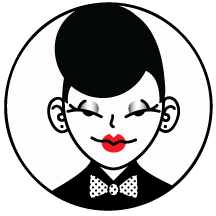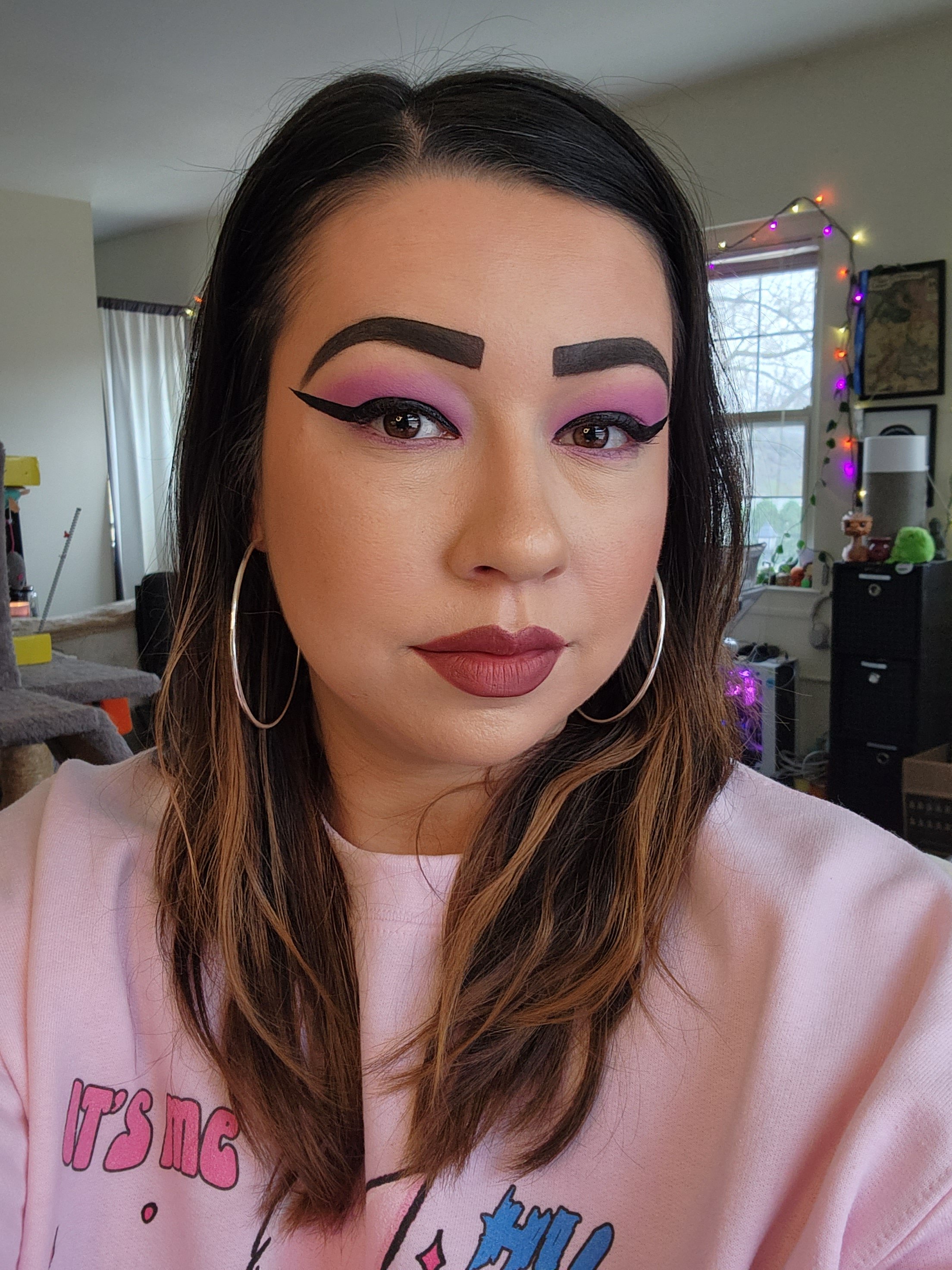A close-up shot of Katlin wearing a pastel pink sweatshirt and silver hoops. Her hair is chest-length, wavy, and is black with caramel highlights. Her makeup consists of pink eye shadow, dark eyebrows, medium eye liner wings in black, and matte, rose lipstick.
Katlin Marisol Sweeney-Romero (she/her) is a PhD candidate in the Department of English at The Ohio State University who specializes in Latinx Studies and popular culture. She is at work on her dissertation, which explores how Latina content creators use social media profiles to produce self-images and an online self. She has published chapters in TikTok Cultures in the United States (Routledge, 2022), Latinx TV in the Twenty-First Century (U of Arizona P, 2022), Cultural Studies in the Digital Age (SDSU Press, 2021), and The Routledge Companion to Gender and Sexuality in Comic Book Studies (Routledge, 2020). She also co-edited a special issue of Prose Studies (vol. 41, no. 2) on Latinx nonfiction with Frederick Luis Aldama. She serves on the Advisory Board for The Latinx Comic Arts Festival (LCAF) at Modesto Junior College and as the Social Media Specialist for the Graduate Student Caucus of the Comics Studies Society.
holding my own gaze
katlin marisol sweeney-romero
When I was a little kid, all I wanted was to be like Sailor Moon.
I could always relate to Usagi’s big emotions, frantic energy, and looming fear that she was going to fail. Those qualities are still pretty accurate to where I am at in my life now. But in the 25 years that have passed since my first Sailor Moon VHS tape was popped into the TV, I always wanted the power to initiate my own “Moon Prism Power!” transformation sequence.
A medium close-up shot of Katlin wearing a light, olive green button-up and earrings shaped like pastel green cacti hanging from a pastel pink oval. Her shoulder-length hair is dyed blueish grey and is pulled back into a high ponytail. Her makeup consists of pastel, glittery green and medium green eye shadows, dark eyebrows, long eye liner wings in black, and rose gold lipstick with a pearly sheen.
My Sailor Moon transformation fixation perhaps makes more sense in the context of my wistful childhood. On the surface, things were fine—perfectly fine, more than fine, nothing-out-of-place-so-don’t-tell-people-if-they-ask-because-we-keep-things-private fine. Under the weight of a fine-tuned suburban veneer, things were finely filtered through a constant state of bated breath. My conservative upbringing in a Catholic household with strict rules and limited exposure to the secular world was further intensified by panicked realizations that I was queer, which I suppressed to make space for the stakes of being a terminally ill parent’s emotional repository for lifelong insecurities and regret. Aside from a few youthful indiscretions and emotional outbursts from the unrelenting stress of the everyday, most of life before 20 was about being someone else’s do-over—someone who reminded me on a near daily basis that it was my responsibility to rectify his failures, that it was my responsibility to repay his presence in my life by generously offering up my own as his second draft. The moments in between these mounting pressures, when I could just sit in front of the TV and watch a fellow anxious girl transform herself from ordinary to extraordinary, meant everything to me.
A medium close-up shot of Katlin wearing a navy blue, turtleneck sweater and a “Don’t @ Me” enamel pin. Her hair is dyed sea green and pulled up into a messy bun behind a black, floral bandana. Her makeup consists of pastel, glittery blue and medium blue eye shadows, dark eyebrows, long eye liner wings in black, and matte, mauve lipstick.
Sailor Moon’s power, of course, literally materializes as the magic she wields to fight her enemies and save the day, but I was transfixed by the figurative magic of her self-adornment that initiated each fight scene. Never in my childhood did I have access to a fully autonomous, physical transformation; every haircut, article of clothing, weight gain, makeup application, and intimate doctor’s visit was forcibly filtered through my parents’ regulation. By contrast, Usagi’s transformation sequence is all about her, and only her. The sequence begins as a fresh coat of glittery appeared below my knees and used both hands to trace the outline of a tiara on my forehead. This practice became sacred to me, became soothing to the parts of my soul that were screaming to come out but knew the unspoken consequences of being myself without permission. I rewound the VHS over and over and over again as I performed this ritual over and over and over again. Each time, I believed that if I believed hard enough, I could summon that power, too.
A medium close-up shot of Katlin wearing a blue polka dot blouse and a bright pink beret with white stitching that reads, “Somebunny loves you” between two white bunnies. Her hair is in loose waves and is dyed cerulean blue. Her makeup consists of bright pink eye shadow, dark eyebrows, medium eye liner wings in black, and matte, rose lipstick.
After years of prolonged proximity to my childhood hometown, I finally moved out of state and started my own life at 24. The distance granted me the space I needed to process a lot about my childhood, especially the parts that were firmly tethered to a different version of events told to me about how my experiences happened. More importantly, it gave me a chance to become a person entirely of my own making. It is a hard experience to put into words—that life before my mid-20s was an exercise in reworking personal boundaries into negotiations for the comfort of people close to you—in being a person who never says no and who never lets other people down.
It is hard to accept that these moments, too, remain a part of me, even as I fight to get older, to stay alive, to remember that when it all seems impossible, it is because I am coming into my own for the first time. It is a hard experience to put into words that I am in permanent grief over the childhood that was fine, over the childhood that maybe was not actually fine.
A medium close-up shot of Katlin wearing a sheer, beige button-up with skulls and orange Jack-o-lantern earrings. Her hair is long, straight, and dyed medium purple. Her makeup consists of iridescent purple eye shadow, dark eyebrows, medium eye liner wings in black, and matte, fuchsia lipstick.
But I made it through, I make it through, I will make it through, in the solace of my self-adornment—a shield that makes my body my own for the first time with each new layer of clothing and makeup I try on as I meet myself. With each spare moment I reallocate towards discovering and redefining my self-adornment practices, my lingering resentments, embarrassments, needs for clarification, blend into the background.
I spend hours staring into the mirror as I practice applying iridescent glitter, colorful eye shadow, and bold lipsticks, assessing with each pat and swipe which cosmetic will become part of my cosmetic arsenal. I wake up before 6 a.m. most days to have enough time to test different techniques when drawing on eye liner wings, with my ever-evolving wing shape becoming my signature facial feature. I study online makeup tutorials, test the consistency of different products in a range of temperatures, and experiment with unexpected color combinations. I spend hours searching for inexpensive statement pieces I can wear to accentuate my makeup. I scour small makers’ shops on Etsy for unique earrings that could extend the storytelling I tell with my cosmetics. I alternate between growing my hair out past my waist to cutting it short into a bob that I dye blue, then purple, then back to blue, back to purple, then back to black with highlights. I go back to the child self I lost touch with each time I remember to spin, to smile, to laugh, to extend my arms and kick my feet out as I transform in the mirror and through the camera.
A close-up shot of Katlin wearing a lime green scarf, olive green shirt, and iridescent crescent moon earrings. Her hair is long, straight, and her black hair has ends dyed medium blue. Her makeup consists of lime green eye shadow, dark eyebrows, long eye liner wings in black, and matte, burgundy lipstick.
With each new look, I pause to take photos—at different angles, in different lighting, with different poses, in different places. I take the photos when I embrace the euphoria of my makeup, accessories, and clothing blending together to form a perfect moment. I take the photos when I feel the sinking sadness of my makeup, accessories, and clothing being out of sync, only to find months or years later that I was not ready to see the beauty in them yet. These photos often enable a periodic review in which I make mental note of what elements I wish to standardize in my routine, what to adjust, and what to do away with. In quieter moments, these photos form the through line of my memories that prove I was here, that I created something beautiful—something special in its ethereality, in its inability to be replicated perfectly. Each photo traces the contours of my spirit, of my hand as it moves across my face and body to summon the energy necessary to persevere. They preserve a life lived in the vivid color of self-adorned expression.
A lit mirror selfie of Katlin looking into her phone, wearing a dark turtleneck sweater and dangly earrings. Her hair is long, straight, and her black hair has ends dyed medium blue. Her makeup consists of pastel blue eye shadow, dark eyebrows, long eye liner wings in black, and matte, rose lipstick.
A close-up shot of Katlin wearing a blue shirt and clear, glittery earrings that read, “Mom, I’m a Rich Man.” Her hair is solid black and pulled back into a low bun. Her makeup consists of neutral, shimmery eye shadow, dark eyebrows, long eye liner wings in blue ombre, and matte, rose lipstick.
A close-up shot of Katlin wearing a grey sweatshirt and silver hoops. Her hair is shoulder-length, wavy, and is black with caramel highlights. Her makeup consists of smokey grey eye shadow, dark eyebrows, medium eye liner wings in black, and matte, rose lipstick.









